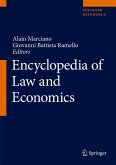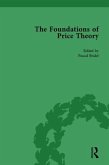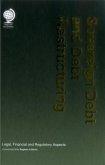Stephen J Spurr
Economic Foundations of Law
Stephen J Spurr
Economic Foundations of Law
- Gebundenes Buch
- Merkliste
- Auf die Merkliste
- Bewerten Bewerten
- Teilen
- Produkt teilen
- Produkterinnerung
- Produkterinnerung
Economic Foundations of Law introduces readers to the economic analysis of the major areas of the law: property law, torts, contracts, criminal law, civil procedure, corporation law, taxation, and labor law. The third edition has been updated with the latest cases and developments throughout.
Andere Kunden interessierten sich auch für
![Patent Policy Patent Policy]() Pia WeissPatent Policy186,99 €
Pia WeissPatent Policy186,99 €![Encyclopedia of Law and Economics Encyclopedia of Law and Economics]() Encyclopedia of Law and Economics1.198,99 €
Encyclopedia of Law and Economics1.198,99 €![Foundations of Non-Cooperative Game Theory Foundations of Non-Cooperative Game Theory]() Klaus RitzbergerFoundations of Non-Cooperative Game Theory223,99 €
Klaus RitzbergerFoundations of Non-Cooperative Game Theory223,99 €![Foundations of Economics Foundations of Economics]() Yanis VaroufakisFoundations of Economics200,99 €
Yanis VaroufakisFoundations of Economics200,99 €![The Foundations of Price Theory Vol 1 The Foundations of Price Theory Vol 1]() Pascal BridelThe Foundations of Price Theory Vol 1197,99 €
Pascal BridelThe Foundations of Price Theory Vol 1197,99 €![Foundations of a Sustainable Economy Foundations of a Sustainable Economy]() Foundations of a Sustainable Economy174,99 €
Foundations of a Sustainable Economy174,99 €![Sovereign Debt and Debt Restructuring Sovereign Debt and Debt Restructuring]() Sovereign Debt and Debt Restructuring266,99 €
Sovereign Debt and Debt Restructuring266,99 €-
-
-
Economic Foundations of Law introduces readers to the economic analysis of the major areas of the law: property law, torts, contracts, criminal law, civil procedure, corporation law, taxation, and labor law. The third edition has been updated with the latest cases and developments throughout.
Hinweis: Dieser Artikel kann nur an eine deutsche Lieferadresse ausgeliefert werden.
Hinweis: Dieser Artikel kann nur an eine deutsche Lieferadresse ausgeliefert werden.
Produktdetails
- Produktdetails
- Verlag: Taylor & Francis
- 3rd edition
- Seitenzahl: 348
- Erscheinungstermin: 5. Februar 2019
- Englisch
- Abmessung: 244mm x 170mm x 22mm
- Gewicht: 794g
- ISBN-13: 9780815375449
- ISBN-10: 0815375441
- Artikelnr.: 55343709
- Herstellerkennzeichnung
- Libri GmbH
- Europaallee 1
- 36244 Bad Hersfeld
- gpsr@libri.de
- Verlag: Taylor & Francis
- 3rd edition
- Seitenzahl: 348
- Erscheinungstermin: 5. Februar 2019
- Englisch
- Abmessung: 244mm x 170mm x 22mm
- Gewicht: 794g
- ISBN-13: 9780815375449
- ISBN-10: 0815375441
- Artikelnr.: 55343709
- Herstellerkennzeichnung
- Libri GmbH
- Europaallee 1
- 36244 Bad Hersfeld
- gpsr@libri.de
Stephen J. Spurr is a Professor of Economics at Wayne State University, USA. He obtained his J.D. from the University of Michigan Law School and a Ph.D. in economics from the University of Chicago. His primary research interests are in the areas of labor economics and economic analysis of law. He has published many articles in highly ranked economics and law journals.
1 Principles of microeconomics (I)
A basic principle: the fungibility of money
Cost
Demand curves and supply curves
The equilibrium of a competitive market
Price ceilings
The market for lawyers
The factor market
The effects of a tax
The effects of a subsidy
Elasticities
Income and substitution effects
2 Principles of microeconomics (II)
Monopolies and cartels
Relation between marginal and average amounts
Cartels
Game theory and the prisoners' dilemma
Rent-seeking behavior
Capital; human capital
The present value of future payments
Interest rates
Efficient capital markets
Externalities
Attitudes toward risk
Markets with incomplete information
Public goods
Appendix 2.1: Continuous compounding
3 Introduction to the legal system
Litigation and the court system
Precedents and the common law
Different standards of proof
The U.S. Constitution
The division of jurisdiction between federal and state courts
4 Property law
Efficiency
Transactions costs
Bilateral monopoly
How disputes are decided by law
The Coase Theorem
Eminent domain
Self-assessment
How the entitlement should be protected
How to determine ownership of property
Intellectual property
5 Problems of incomplete property rights
Inalienability
Problems when there are no property rights
Problems when property rights are divided
Problems when property rights are uncertain
Limits on the disposition of property at death
Appendix 5.1 When should a tree be harvested?
6 Informal creation of property rights
Property rights in surfing
The Gold Rush
Sharecropping contracts
Whaling customs
The division of profits in law firms
The Shakers
7 The law of contracts
The economic functions of the law of contracts
General rules of contract law
The common law of slavery
The controversy concerning standard form contracts
Unconscionability
Remedies for breach of contract
The lost-volume or expansible seller
Specific performance
Liquidated damages and penalties
8 Torts
Negligence
Strict liability
The Learned Hand rule
The law of rescue
The collateral source rule
Comparative negligence
More on strict liability
Medical malpractice
Contribution
Damages
Subrogation
Subrogation and potential moral hazard of tort victims
The economics of subrogation
Moral hazard arising from abolition of the collateral source rule
A note on trial strategy: should the jury know about insurance?
Whether dangerous conduct should be controlled by tort law or regulation
No-fault automobile insurance
9 The economics of litigation
An optimal judicial system
The standard of proof for a preliminary injunction
The economic model of litigation
Pre-trial discovery
Procedural rules which make litigation more efficient
Agency problems
Potential benefits of class actions
Waivers of the right to participate in class actions
The English rule
Court delay
Expert witnesses
Determining the quality of a judge (or court)
Whether the common law is efficient
Rules of collateral estoppel
The jury
Juries in death penalty cases
Analyzing litigation with game theory
An example involving Rule 68
Deciding whether to file a lawsuit
The solution under the American rule
The solution under the English rule
An example with two players
An example of subrogation, with no injury if tortfeasor takes care
A. Under the American rule
B. Under the English rule
10 Criminal law
The economic model of crime and punishment
The optimal type of punishment
An application: Megan's Laws
Evaluating the system of law enforcement
Measuring the determinants of crime and the benefits of law enforcement
Markets for crime
Externalities resulting from precautions taken against crime; Lojack
The economics of gun ownership and use
Gun ownership and "hot" burglaries
Concealed-carry and right-to-carry laws
Laws restricting access to firearms
A proposed tax on firearms
Gun buyback programs
Changing the design of firearms
Regulation of bullets
Factors affecting the quality of law enforcement
Public versus private enforcement of law
11 Corporations and financial markets
The characteristics of the corporation
Common and preferred stock
Potential conflicts between managers and stockholders
Compensation of investment advisors
The competition to be the state of incorporation
The prohibition of insider trading
Conflicts among shareholders
Deposit insurance and moral hazard
Bankruptcy law
The economics of bank regulation
12 Taxation
The effects of a death tax
Social security
The effect on savings of tax rules concerning interest
The proposal for a tax on consumption
Charitable contributions
Depreciation
Percentage depletion
The subsidy for residential housing
The social cost of the tax exemption of interest on municipal bonds
13 Labor law
Covenants not to compete
General and firm-specific human capital
Maximum and minimum wages
Employment protection laws
Market Adjustments to Employment Protection Laws
Regulation of pensions
Comparable worth
Glossary
Notes
Index
A basic principle: the fungibility of money
Cost
Demand curves and supply curves
The equilibrium of a competitive market
Price ceilings
The market for lawyers
The factor market
The effects of a tax
The effects of a subsidy
Elasticities
Income and substitution effects
2 Principles of microeconomics (II)
Monopolies and cartels
Relation between marginal and average amounts
Cartels
Game theory and the prisoners' dilemma
Rent-seeking behavior
Capital; human capital
The present value of future payments
Interest rates
Efficient capital markets
Externalities
Attitudes toward risk
Markets with incomplete information
Public goods
Appendix 2.1: Continuous compounding
3 Introduction to the legal system
Litigation and the court system
Precedents and the common law
Different standards of proof
The U.S. Constitution
The division of jurisdiction between federal and state courts
4 Property law
Efficiency
Transactions costs
Bilateral monopoly
How disputes are decided by law
The Coase Theorem
Eminent domain
Self-assessment
How the entitlement should be protected
How to determine ownership of property
Intellectual property
5 Problems of incomplete property rights
Inalienability
Problems when there are no property rights
Problems when property rights are divided
Problems when property rights are uncertain
Limits on the disposition of property at death
Appendix 5.1 When should a tree be harvested?
6 Informal creation of property rights
Property rights in surfing
The Gold Rush
Sharecropping contracts
Whaling customs
The division of profits in law firms
The Shakers
7 The law of contracts
The economic functions of the law of contracts
General rules of contract law
The common law of slavery
The controversy concerning standard form contracts
Unconscionability
Remedies for breach of contract
The lost-volume or expansible seller
Specific performance
Liquidated damages and penalties
8 Torts
Negligence
Strict liability
The Learned Hand rule
The law of rescue
The collateral source rule
Comparative negligence
More on strict liability
Medical malpractice
Contribution
Damages
Subrogation
Subrogation and potential moral hazard of tort victims
The economics of subrogation
Moral hazard arising from abolition of the collateral source rule
A note on trial strategy: should the jury know about insurance?
Whether dangerous conduct should be controlled by tort law or regulation
No-fault automobile insurance
9 The economics of litigation
An optimal judicial system
The standard of proof for a preliminary injunction
The economic model of litigation
Pre-trial discovery
Procedural rules which make litigation more efficient
Agency problems
Potential benefits of class actions
Waivers of the right to participate in class actions
The English rule
Court delay
Expert witnesses
Determining the quality of a judge (or court)
Whether the common law is efficient
Rules of collateral estoppel
The jury
Juries in death penalty cases
Analyzing litigation with game theory
An example involving Rule 68
Deciding whether to file a lawsuit
The solution under the American rule
The solution under the English rule
An example with two players
An example of subrogation, with no injury if tortfeasor takes care
A. Under the American rule
B. Under the English rule
10 Criminal law
The economic model of crime and punishment
The optimal type of punishment
An application: Megan's Laws
Evaluating the system of law enforcement
Measuring the determinants of crime and the benefits of law enforcement
Markets for crime
Externalities resulting from precautions taken against crime; Lojack
The economics of gun ownership and use
Gun ownership and "hot" burglaries
Concealed-carry and right-to-carry laws
Laws restricting access to firearms
A proposed tax on firearms
Gun buyback programs
Changing the design of firearms
Regulation of bullets
Factors affecting the quality of law enforcement
Public versus private enforcement of law
11 Corporations and financial markets
The characteristics of the corporation
Common and preferred stock
Potential conflicts between managers and stockholders
Compensation of investment advisors
The competition to be the state of incorporation
The prohibition of insider trading
Conflicts among shareholders
Deposit insurance and moral hazard
Bankruptcy law
The economics of bank regulation
12 Taxation
The effects of a death tax
Social security
The effect on savings of tax rules concerning interest
The proposal for a tax on consumption
Charitable contributions
Depreciation
Percentage depletion
The subsidy for residential housing
The social cost of the tax exemption of interest on municipal bonds
13 Labor law
Covenants not to compete
General and firm-specific human capital
Maximum and minimum wages
Employment protection laws
Market Adjustments to Employment Protection Laws
Regulation of pensions
Comparable worth
Glossary
Notes
Index
1 Principles of microeconomics (I)
A basic principle: the fungibility of money
Cost
Demand curves and supply curves
The equilibrium of a competitive market
Price ceilings
The market for lawyers
The factor market
The effects of a tax
The effects of a subsidy
Elasticities
Income and substitution effects
2 Principles of microeconomics (II)
Monopolies and cartels
Relation between marginal and average amounts
Cartels
Game theory and the prisoners' dilemma
Rent-seeking behavior
Capital; human capital
The present value of future payments
Interest rates
Efficient capital markets
Externalities
Attitudes toward risk
Markets with incomplete information
Public goods
Appendix 2.1: Continuous compounding
3 Introduction to the legal system
Litigation and the court system
Precedents and the common law
Different standards of proof
The U.S. Constitution
The division of jurisdiction between federal and state courts
4 Property law
Efficiency
Transactions costs
Bilateral monopoly
How disputes are decided by law
The Coase Theorem
Eminent domain
Self-assessment
How the entitlement should be protected
How to determine ownership of property
Intellectual property
5 Problems of incomplete property rights
Inalienability
Problems when there are no property rights
Problems when property rights are divided
Problems when property rights are uncertain
Limits on the disposition of property at death
Appendix 5.1 When should a tree be harvested?
6 Informal creation of property rights
Property rights in surfing
The Gold Rush
Sharecropping contracts
Whaling customs
The division of profits in law firms
The Shakers
7 The law of contracts
The economic functions of the law of contracts
General rules of contract law
The common law of slavery
The controversy concerning standard form contracts
Unconscionability
Remedies for breach of contract
The lost-volume or expansible seller
Specific performance
Liquidated damages and penalties
8 Torts
Negligence
Strict liability
The Learned Hand rule
The law of rescue
The collateral source rule
Comparative negligence
More on strict liability
Medical malpractice
Contribution
Damages
Subrogation
Subrogation and potential moral hazard of tort victims
The economics of subrogation
Moral hazard arising from abolition of the collateral source rule
A note on trial strategy: should the jury know about insurance?
Whether dangerous conduct should be controlled by tort law or regulation
No-fault automobile insurance
9 The economics of litigation
An optimal judicial system
The standard of proof for a preliminary injunction
The economic model of litigation
Pre-trial discovery
Procedural rules which make litigation more efficient
Agency problems
Potential benefits of class actions
Waivers of the right to participate in class actions
The English rule
Court delay
Expert witnesses
Determining the quality of a judge (or court)
Whether the common law is efficient
Rules of collateral estoppel
The jury
Juries in death penalty cases
Analyzing litigation with game theory
An example involving Rule 68
Deciding whether to file a lawsuit
The solution under the American rule
The solution under the English rule
An example with two players
An example of subrogation, with no injury if tortfeasor takes care
A. Under the American rule
B. Under the English rule
10 Criminal law
The economic model of crime and punishment
The optimal type of punishment
An application: Megan's Laws
Evaluating the system of law enforcement
Measuring the determinants of crime and the benefits of law enforcement
Markets for crime
Externalities resulting from precautions taken against crime; Lojack
The economics of gun ownership and use
Gun ownership and "hot" burglaries
Concealed-carry and right-to-carry laws
Laws restricting access to firearms
A proposed tax on firearms
Gun buyback programs
Changing the design of firearms
Regulation of bullets
Factors affecting the quality of law enforcement
Public versus private enforcement of law
11 Corporations and financial markets
The characteristics of the corporation
Common and preferred stock
Potential conflicts between managers and stockholders
Compensation of investment advisors
The competition to be the state of incorporation
The prohibition of insider trading
Conflicts among shareholders
Deposit insurance and moral hazard
Bankruptcy law
The economics of bank regulation
12 Taxation
The effects of a death tax
Social security
The effect on savings of tax rules concerning interest
The proposal for a tax on consumption
Charitable contributions
Depreciation
Percentage depletion
The subsidy for residential housing
The social cost of the tax exemption of interest on municipal bonds
13 Labor law
Covenants not to compete
General and firm-specific human capital
Maximum and minimum wages
Employment protection laws
Market Adjustments to Employment Protection Laws
Regulation of pensions
Comparable worth
Glossary
Notes
Index
A basic principle: the fungibility of money
Cost
Demand curves and supply curves
The equilibrium of a competitive market
Price ceilings
The market for lawyers
The factor market
The effects of a tax
The effects of a subsidy
Elasticities
Income and substitution effects
2 Principles of microeconomics (II)
Monopolies and cartels
Relation between marginal and average amounts
Cartels
Game theory and the prisoners' dilemma
Rent-seeking behavior
Capital; human capital
The present value of future payments
Interest rates
Efficient capital markets
Externalities
Attitudes toward risk
Markets with incomplete information
Public goods
Appendix 2.1: Continuous compounding
3 Introduction to the legal system
Litigation and the court system
Precedents and the common law
Different standards of proof
The U.S. Constitution
The division of jurisdiction between federal and state courts
4 Property law
Efficiency
Transactions costs
Bilateral monopoly
How disputes are decided by law
The Coase Theorem
Eminent domain
Self-assessment
How the entitlement should be protected
How to determine ownership of property
Intellectual property
5 Problems of incomplete property rights
Inalienability
Problems when there are no property rights
Problems when property rights are divided
Problems when property rights are uncertain
Limits on the disposition of property at death
Appendix 5.1 When should a tree be harvested?
6 Informal creation of property rights
Property rights in surfing
The Gold Rush
Sharecropping contracts
Whaling customs
The division of profits in law firms
The Shakers
7 The law of contracts
The economic functions of the law of contracts
General rules of contract law
The common law of slavery
The controversy concerning standard form contracts
Unconscionability
Remedies for breach of contract
The lost-volume or expansible seller
Specific performance
Liquidated damages and penalties
8 Torts
Negligence
Strict liability
The Learned Hand rule
The law of rescue
The collateral source rule
Comparative negligence
More on strict liability
Medical malpractice
Contribution
Damages
Subrogation
Subrogation and potential moral hazard of tort victims
The economics of subrogation
Moral hazard arising from abolition of the collateral source rule
A note on trial strategy: should the jury know about insurance?
Whether dangerous conduct should be controlled by tort law or regulation
No-fault automobile insurance
9 The economics of litigation
An optimal judicial system
The standard of proof for a preliminary injunction
The economic model of litigation
Pre-trial discovery
Procedural rules which make litigation more efficient
Agency problems
Potential benefits of class actions
Waivers of the right to participate in class actions
The English rule
Court delay
Expert witnesses
Determining the quality of a judge (or court)
Whether the common law is efficient
Rules of collateral estoppel
The jury
Juries in death penalty cases
Analyzing litigation with game theory
An example involving Rule 68
Deciding whether to file a lawsuit
The solution under the American rule
The solution under the English rule
An example with two players
An example of subrogation, with no injury if tortfeasor takes care
A. Under the American rule
B. Under the English rule
10 Criminal law
The economic model of crime and punishment
The optimal type of punishment
An application: Megan's Laws
Evaluating the system of law enforcement
Measuring the determinants of crime and the benefits of law enforcement
Markets for crime
Externalities resulting from precautions taken against crime; Lojack
The economics of gun ownership and use
Gun ownership and "hot" burglaries
Concealed-carry and right-to-carry laws
Laws restricting access to firearms
A proposed tax on firearms
Gun buyback programs
Changing the design of firearms
Regulation of bullets
Factors affecting the quality of law enforcement
Public versus private enforcement of law
11 Corporations and financial markets
The characteristics of the corporation
Common and preferred stock
Potential conflicts between managers and stockholders
Compensation of investment advisors
The competition to be the state of incorporation
The prohibition of insider trading
Conflicts among shareholders
Deposit insurance and moral hazard
Bankruptcy law
The economics of bank regulation
12 Taxation
The effects of a death tax
Social security
The effect on savings of tax rules concerning interest
The proposal for a tax on consumption
Charitable contributions
Depreciation
Percentage depletion
The subsidy for residential housing
The social cost of the tax exemption of interest on municipal bonds
13 Labor law
Covenants not to compete
General and firm-specific human capital
Maximum and minimum wages
Employment protection laws
Market Adjustments to Employment Protection Laws
Regulation of pensions
Comparable worth
Glossary
Notes
Index








